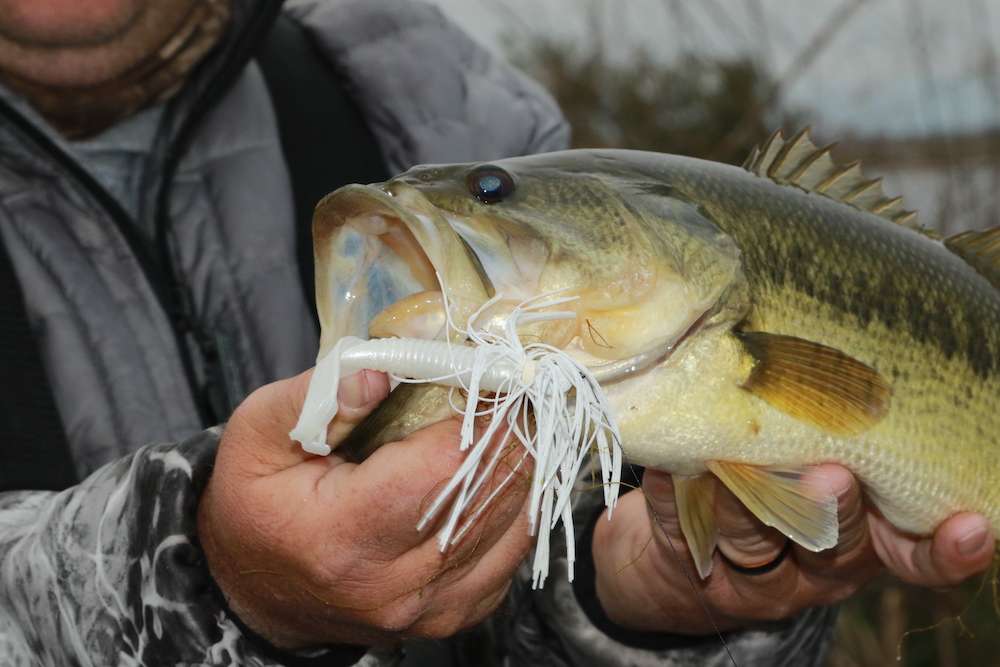
Gone are the greenish canopies that provide shady solace during hot summer days, but don’t assume a pad field’s appeal lies solely in its overhead cover. Come the prespawn, the stalky remains play big for staging bass.
When vast fields of lily pads shrivel during winter, their vanishing canopies leave only the skeletal remains of what anglers simply call “pad stems.” Lacking the overhead cover, these areas lose much of the shade that bass seek during the hotter times.
Late winter-early spring, however, finds fish relating to shallow cover near their spawning destinations. Here, fish find warmth in the darker vegetation, along with last-minute feeding opportunities. Cast the right bait into this zone and you’ll often see the stems parting as a big fish makes its way toward your offering.
“Usually, that’s one of the few types of cover that remains through the winter,” Elite angler Keith Combs said of the pad stems’ seasonal relevance.
Fellow Elite Bill Lowen agrees and notes the broad attraction: “I think anywhere in the country that’s a good option. I think those areas where pad stems are growing have a darker, muckier bottom and that stuff warms up faster.”
Influencing factors
Obviously, sunny days fuel that heating blanket effect, while also cracking the whip on prespawn advancement. Conversely, while a cold front tempers the fish’s aggression, declining temperatures amplify the habitat’s appeal.
Consider, also, how the wind cold fronts bring will impact the fish. During the 2020 the Basspro.com Bassmaster Eastern Open on Florida’s Kissimmee Chain, Scott Martin found that the fish he’d been targeting amid pad stems vacated the habitat when a big Day 3 wind created a harsh, whipping environment.
“Wind also stirs up the soft bottom where those pads grow, and it’s worst in Florida,” Combs said. “When you get a big wind in Florida, you get debris-filled water. It’s not just a stain — all that decayed vegetation gets stirred up, and the fish don’t like that.

“It’s not like in Texas, were it’s more silt that settles quicker. When Florida lakes get stirred by the wind, it takes a lot longer to settle.”
What to look for
Combs said he starts with area recon. In these relatively shallow areas where pads grow, a point, ridge or hump consistently attracts fish. Voids in the pad stem field indicates a high spot where pads couldn’t establish during a low water period.
“If you see denser areas of pads, that can indicate a ditch or drain, which are their routes to the spawning zone,” Combs said.
Also, look for stumps, laydowns or duck blinds, as anything out of the ordinary means natural fish attraction. Take note of where these items exist and pay attention to daily fish positioning.
“The way you can kinda tell (seasonal advancement) is how far they’re progressing into the pad field,” Lowen said. “They start in the ditch heads and edges, but as they get closer to the spawn, they get shallower and shallower.
“When they finally reach that hard edge — the bank line — that’s where it’s all going to go down.”
What they like
Given the typically broad scope of a pad stem field, most agree with the logic of initially covering water with moving baits. Sometimes, this ends up being all you need, but there are a couple ways of going about it.

Lowen starts with a 1/4-ounce Lure Parts Online swim jig with a boot tail trailer like the Strike King Caffeine Swimming Shad or Rage Swimmer. The latter has a little more aggressive look with its wider wobble, but as the water warms, Lowen wants even more enticement, so he switches to a Strike King Rage Craw.
“I can slow roll that swim jig through there and tick it off those stems and no have to worry about it getting all gummed up in the trash,” he said. “You have old dead, decaying pads and stems laying on the bottom.”
Lowen said he’ll try to bump the stems to trigger a bite. He’ll also occasionally let his bait come tight in the gunk and then pull it free — like ripping a lipless bait through grass — to trigger a bite.
“I also like a bladed jig or a rattle bait like the Ima Suspending Rocking Vibe when the fish are very aggressive,” Lowen said. “With that suspended bait, you can kinda fish it like a Carolina rig through the pad stems; you pull and pause, pull and pause. That keeps you from getting down in the junk because that stuff gets on your bait pretty easily.
“If a colder front comes through, I’ll always have a slower bait sitting there to pitch around,” Lowen said. “I want something without a lot of action like a 5-inch Strike King Ocho with a 1/16- to 3/16-ounce weight.
“I want to float over the cover, not sink into it. I’ll pitch at particulars targets when I feel they’re being a little funky.”
With his moving bait presentations heavy on the swim jig, Combs mixes in a 3/8-ounce chartreuse/white spinnerbait with tandem willow blades. For deeper drains, he likes a Strike King Two Tap lipless bait.
When it’s time to target specific cover, Combs finds it hard to beat a 1/2-ounce black and blue Strike King Hack Attack jig with a Rage Craw. Fishing this bait in the right places, he said, can be highly productive.
“Usually, if I see a duck blind or a piece of wood, I’ll fish it several times throughout the day because these spots replenish,” he said. “I might catch a fish there in the morning and then come back and catch another on in the afternoon.
“The thing about the prespawn is they’re always coming. And after the spawn, they’ll be coming back out, so these pad stems (and the isolated cover within) will be good again.”






